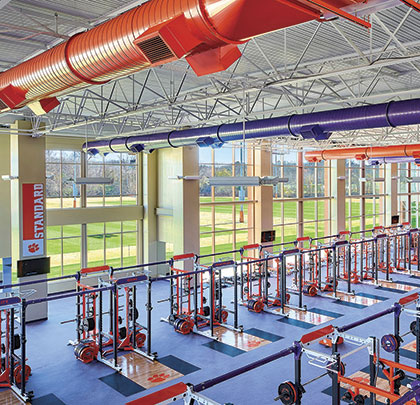Too often when educational facilities look to add unique or architecturally impactful buildings on campus, restrictive fire codes put a damper on designs or threaten to significantly increase costs and compromise functionality.
However, Clemson University, which recently constructed a new state-of-the-art home for its 2016 NCAA championship football team, was able to rethink conventional wisdom with a radical, more flexible approach to fire code interpretations.
NEW APPROACH TO SAFETY
The Allen N. Reeves Football Complex is the first in South Carolina history to utilize a performance-based design code analysis approach (tested to meet specific goals) to fire code safety, instead of a traditional prescriptive approach (adhering strictly to written codes), according to Paul Borick, one of Clemson University’s Capital Projects project managers for renovations and new construction.
“Universities have so many uniquely shaped or large volume spaces—like sports centers, pools, weight rooms, aerobic rooms, as well as classrooms and labs pushed up against multistory structures and assembly areas—that don’t quite fit the prescriptive fire code,” says Borick.
PERFORMANCE-BASED DESIGN
In traditional prescriptive-based designs, building codes usually require specific, measurable design criteria that are meant to govern typical building situations, based on past loss history and standard construction methods. While this works well in routine cases, the approach can lack flexibility when buildings have unusual design parameters.
As an International Code Council (ICC) accepted alternative, however, performance-based design allows “alternate materials and methods” that offer equivalent or superior fire safety performance. In terms of enhancing fire safety, this often involves utilizing scientific calculations and engineering, as well as computer fire modeling to determine how a building would respond to fire. With this approach, a design is considered acceptable if the fire engineering calculations demonstrate that it meets the measurable performance criteria set at the start of the process.
In Clemson’s case, to consolidate operations the university sought to construct the 142,500-square-foot Allen N. Reeves Football Complex adjacent to its existing indoor football practice facility and outdoor practice fields.
The state-of-the-art building, designed by architecture firms Goodwyn Mills and Cawood, Inc. (GMC) and HOK, adjoins the indoor practice facility and outdoor practice fields, consolidating football operations into one complex. The complex features include 1.5 acres of outdoor leisure and entertainment space, hydrotherapy, training, weight room, steam room, recovery room, and a Gatorade fuel bar.
“We wanted to put a new two-story football complex building next to our indoor practice facility, which has a full football field, but the prescriptive code made this difficult,” says Borick, who sought to avoid separating the two buildings in order to keep the team on a tight, regimented schedule.
According to Borick, this design was important to allow players to go from one area to the next (such as from the weightlifting room to the practice field) without having to walk outside in adverse weather conditions.
“The challenge was that if we attached the two buildings, the prescriptive code would have required us to separate the buildings by 60 feet or create a firewall between them, as well as fireproof all the existing structural steel in our big, open 100,000-square-foot facility,” says Borick. “This would have cost well over $1 million, so we had to find an alternative.”
Clemson University turned to Jensen Hughes Inc., one of world’s the largest fire protection and life safety engineering and consulting firms. In addition, as required by the South Carolina Office of State Engineer, the university employed Fisher Engineering Fire Protection Engineers to perform an independent third-party peer review of the Jensen Hughes performance-based code analysis. Fisher also had extensive experience with performance-based designs.
“The way the building was configured, it did not fit into the prescriptive requirement box,” says Mike Ernst, senior fire protection engineer at Jensen Hughes. “So, we looked at the intent of the prescriptive code requirements and asked, ‘What’s the goal? What level of safety is the prescriptive code requirement trying to meet?’”
Due to the project’s unique design requirements, modification of the indoor practice facility was necessary to accommodate the construction of the adjacent two-story building.
“We went back and analyzed how they could configure it to meet the prescriptive code requirements, which meant making a two story building a big single story building,” says Ernst. “We then compared the level of safety of the single story configuration to the desired two-story building configuration.”
By adopting a performance-based design approach, computer egress modeling software, and an innovative smoke detection technology, the university was able to dramatically reduce the project cost while increasing safety.
In a performance-based design approach, it turns out, one of the ways to meet safety code is to utilize egress modeling.
As such, Jensen Hughes employed Pathfinder egress modeling, which enables advanced evaluation of pedestrian movement, evacuation, and congestion studies through software-based simulation. This included going to the facility and observing how the football players moved throughout their existing building and interacted with each other in egress corridors and room exiting.
“Jensen Hughes staff filmed how our football players exited their main team room and moved together before entering their individual position meeting rooms,” says Borick. “They analyzed the video to determine how their exit could be expedited and restrictions removed.”
Along with this, Clemson University utilized advanced smoke detection technology in the form of four VESDA-E VEA fire alarm system units, manufactured by Xtralis, a global provider of early detection and remote visual verification of fire, gas, and perimeter threats.
“For the VEA, your detection time is essentially zero,” says Ernst. “We had multiple scenarios with different levels of occupant loading in the building based on the way the university uses it. Overall, we gained 2-3 minutes of time to egress for each scenario due to early detection [compared to standard detection].”ν
For More Information:
For more information about Xtralis, call 619.252.2015, or visit www.xtralis.com/vea.
_________________________________________________________________________
Modern Contractor Solutions, March 2018
Did you enjoy this article?
Subscribe to the FREE Digital Edition of Modern Contractor Solutions magazine.



